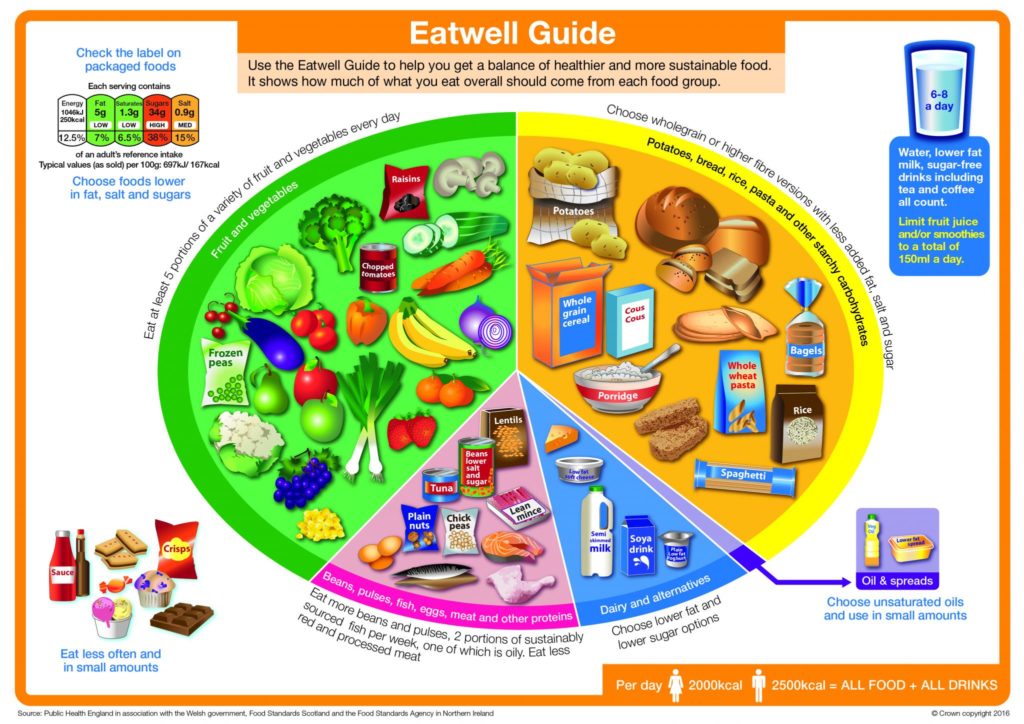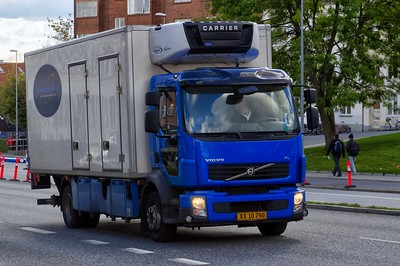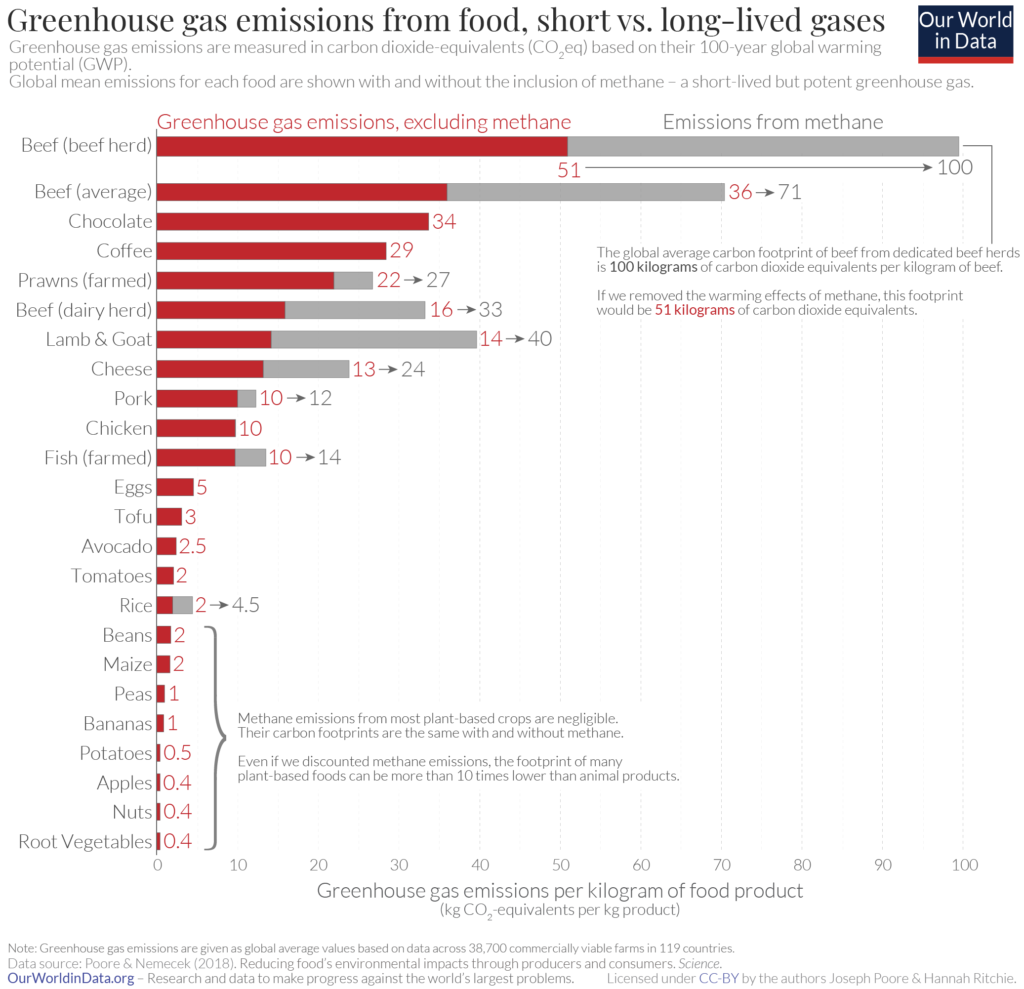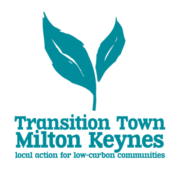Food – Big Ideas

The food we eat
What we eat matters for both our health and the planet’s. Here is the NHS’s version of a healthy plate for us and our families. We’ve all seen it many times.

So what does a PLANET-HEALTHY plate look like?
Here are some suggestions:
- Carbon – neutral i.e. producing this food did not increase emissions of carbon dioxide (CO2)
- Limited methane emissions
- No increase in nitrogen in the atmosphere
- Insect populations were not affected
- Water was used responsibly
- Soil was not degraded or eroded
Carbon emissions and food
Deforestation
Forests, particularly tropical forests, absorb carbon dioxide (CO2) which is the major greenhouse gas heating the planet. When agribusiness clears land for planting, this both releases CO2 and removes the planet’s ability to absorb it. Most deforestation is to create large scale soy plantations – not to feed humans directly, but to produce animal feed. This is why many are choosing to eat less meat and animal products.
Here is a chart showing the ways different foods affect the climate. There is a clear case for cutting meat and dairy consumption.

Transport
Food miles (diesel) and air miles (kerosene) all count and all produce CO2, and, in general, the less distance food has to travel to get to your plate, the better. Certainly, flying in fresh veg from Africa, South East Asia or South America, has a significant CO2 footprint. However, there is a trade-off. Some off-season products, like tomatoes in January, may be produced in greenhouses in the UK and have a very high CO2 footprint compared to ones that are trucked from, say, Southern Europe.

Packaging
Some packaging is made from plastics, such as polythene. These come from fossil fuels. A major use of plastic in food, is the film that is wound round and round pallets. While the packaging that the consumer sees is becoming less fossil fuel based, there have not been any significant moves to reduce the use of film.

Dairy and Meat Farming
The chart below shows the amount of methane and other greenhouse gases (separated out) by food type. It shows the large amounts of methane generated by animal farming. As the graph says, methane is a shorter lived but very potent greenhouse gas; this means that if we reduce methane we could reduce global warming significantly.

This is the reason that many people have decided to reduce or eliminate meat from their diet.
Fertilizers
In 2016, Climate Watch estimated that 4.1% of greenhouse gas production was due to the use of fertilizers adding nitrous oxide (N 2 O) to the atmosphere. This gas has a greenhouse effect 300 times more potent than CO2, but lasts less time in the atmosphere. It is also of concern as it depletes the ozone layer. Furthermore, run off from agricultural land pollutes rivers and water sources with nitrates and ammonia.
Organic farming does not use these fertilizers and this is the reason that those concerned about climate change recommend buying organic produce where possible, or … see here for ideas on growing your own!
Insect Loss
The way we farm is the major reason that insect populations are plummeting; pesticides, land clearance, large tracts of land used for just one kind of crop are all factors. Without insects, we face a catastrophe. This article from The Guardian gives more background.
Organic farming does not use pesticides, so this is another reason why many of us have decided to buy organic where possible.
Water
Nothing grows without water. Agricultural use can be water intensive, especially as temperatures rise. The United Nations World Water Assessment Program sees the need for agricultural, which is responsible for 70% of all business water use, to be more efficient as water becomes scarcer due to climate change and demands for water increase. See the report here.
It is possible to decide not to buy food produced in countries that have water shortages. We can also avoid meat that comes from animals fed on meal from water scarce areas.
Fertilizers and soil dressings leech into rivers, streams and ground water and contaminate our water supplies. Agriculture is a major source of water pollution in the UK. If it’s possible, we could avoid this by buying organic.
Soil
“Healthy soils are the basis for healthy habitats for all living beings. They provide food, clean water, raw materials and various ecosystem services. But salinity, acidification and loss of biodiversity are just some of the threats that soils are currently facing,” according to the United Nations Agricultural Agency. Read the rest of this United Nations News Item here.
There are alternatives to mainstream agricultural practices that tend to be soil destructive. Regenerative agriculture and permaculture are two of them.
Climate Change and Food Waste
Even from a United Nations report in 2013, the figures are impressive: food waste adds 3.3 billion tonnes of greenhouse gases to the atmosphere and 28% (over a quarter) of the world’s agricultural land is used to produce food that is lost or wasted. Reducing food waste does reduce greenhouse gas emissions and contribute to controlling climate change. Read the UN report here.
Suggested Actions
- Buy only as much food as you need.
- Serve only as much food as your family will eat.
- Consider batch cooking for a week ahead (and save on the “I’m too tired to cook” takeaways).
- Freeze left over portions for another day.
- In winter, make soups from left over vegetables and other food.
- Bags of salad and greens can be blitzed to make sauces for pasta.
- Put any peelings, bones, etc. in the green bin so that it is used to produce compost.
- Support local initiatives on food
Contact us with further suggestions, comments and ideas or email us transitiontownmk@protonmail.com

